Phuket is both Thailand’s largest island and its most culturally diverse. In particular, Old Phuket Town, as the historic center of the island’s main city is often referred to, has a fascinatingly complex history stretching back hundreds of years.
While many travelers journey to Phuket to frequent its beaches, the streets of Old Town offer a compelling charm all of their own. With their brightly hued Sino-Portuguese shophouses and home, the main streets of Thalang Road, Krabi Road, and Dibuk Road are wonderfully atmospheric.
Here are some of the best things to see and do in Old Phuket Town.
Visit the Phuket Thai Hua Museum
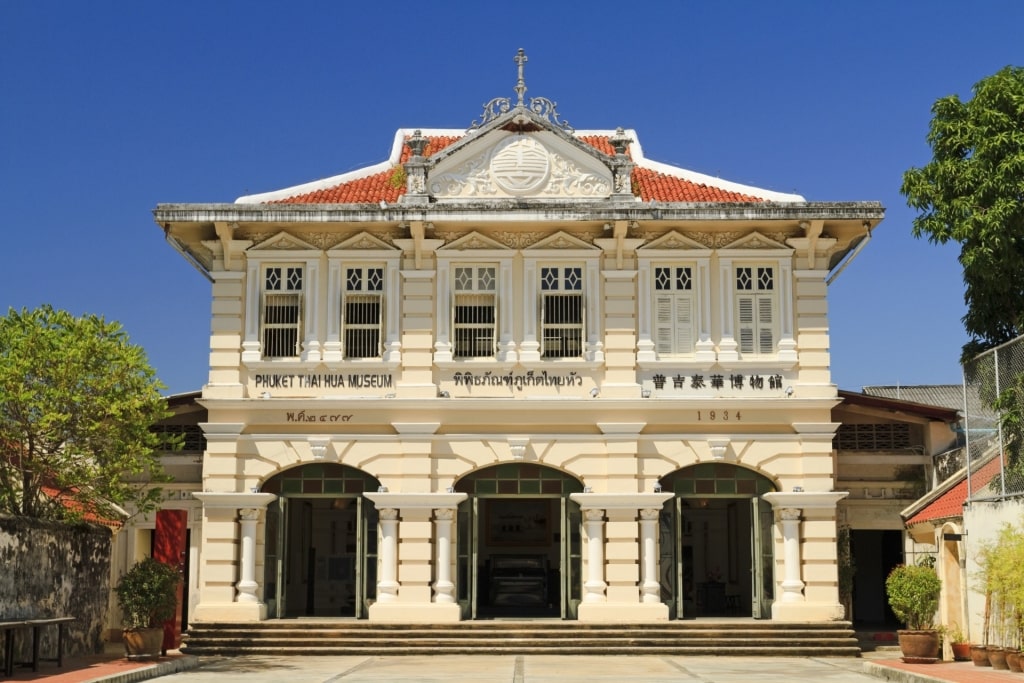
Phuket Thai Hua Museum
For anyone looking to delve into Phuket’s rich, multicultural history, this museum in a converted former Chinese language school merits a stop.
Built in the classic Sino-Portuguese architecture style, the museum is dedicated to telling the story of the Hokkien Chinese immigrants, many of whom first came here as workers in Phuket’s once-booming tin mining industry.
While the exhibits are modest in size and scope, they tell an important piece of the story of the island.
Shop at the Phuket Naka Weekend Market
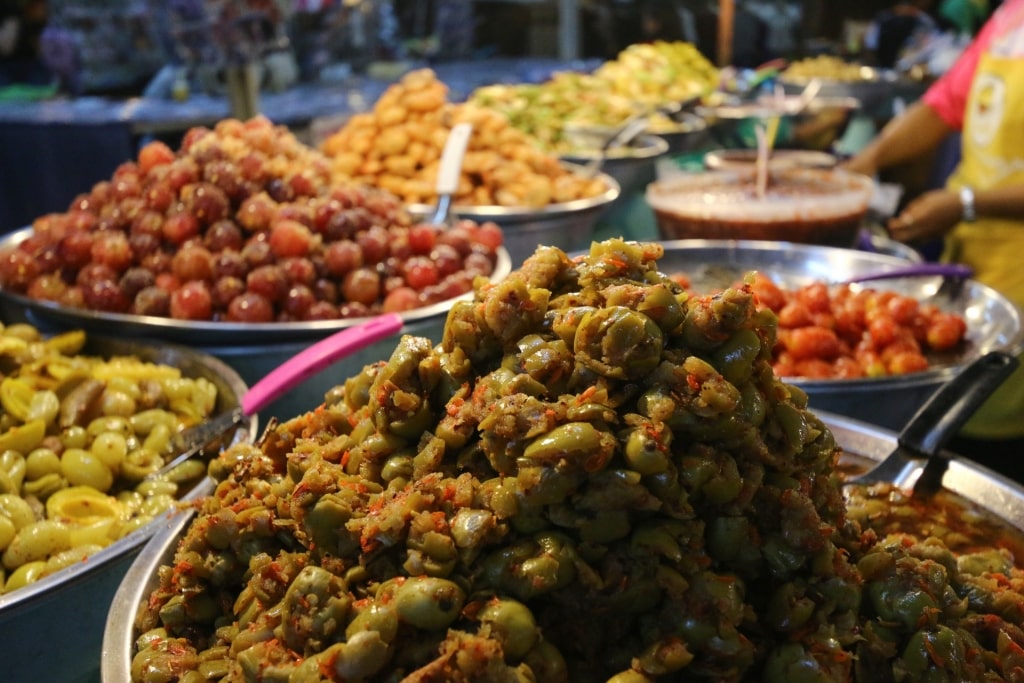
Phuket Naka Weekend Market
Phuket’s sprawling, slightly chaotic weekend market regularly draws comparisons to Chatuchak Weekend Market, or “JJ” as locals call it, in Bangkok.
Much like its big-city sibling, Phuket Naka Weekend Market can feel downright overwhelming to the uninitiated. The combination of crowds and tropical heat can make navigating the labyrinth-like network of vendors daunting, to say the least.
Nevertheless, savvy shoppers will find some real bargains and genuine crafts lurking between the fake brand-name bags and counterfeit watches. Curios, Thai souvenirs, handicrafts, fashion, and bags are all good buys here.
As with Chatuchak Weekend Market, there is a method to the madness here, even if it might not be readily apparent on first glance.
To get the most out of your market experience, go in with a rough plan of which sections you plan to target, stick to off-peak hours, and be sure to pick up bottled water—or a fresh coconut—to stay hydrated.
Better yet, as soon as you feel shopping fatigue beginning to set in, do as the local shoppers do and break for snacks. From a vast array of freshly chopped fruits to sweets and more substantial eats, the culinary options here are dizzying.
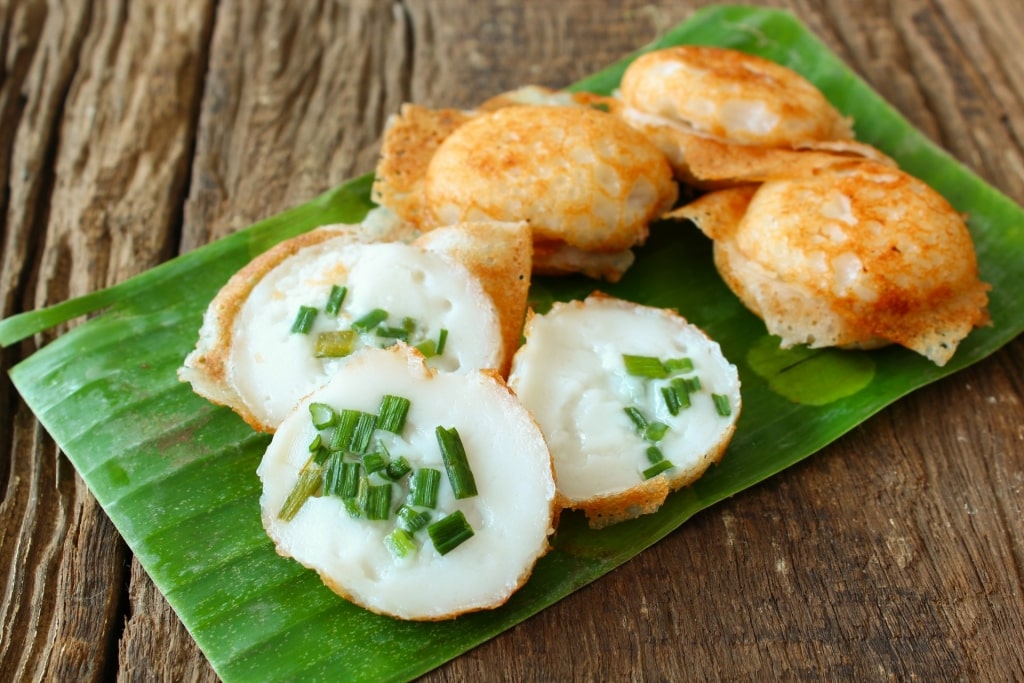
Kanom krok
For a light bite, keep an eye out for kanom krok, hemispherical sweet or savory pancakes made with rice flour that have crispy edges and a coconut custard center.
You can also beat the heat with a few scoops of traditional coconut ice cream, typically served in a fluffy bun garnished with chopped peanuts.
Feast on Crab Curry
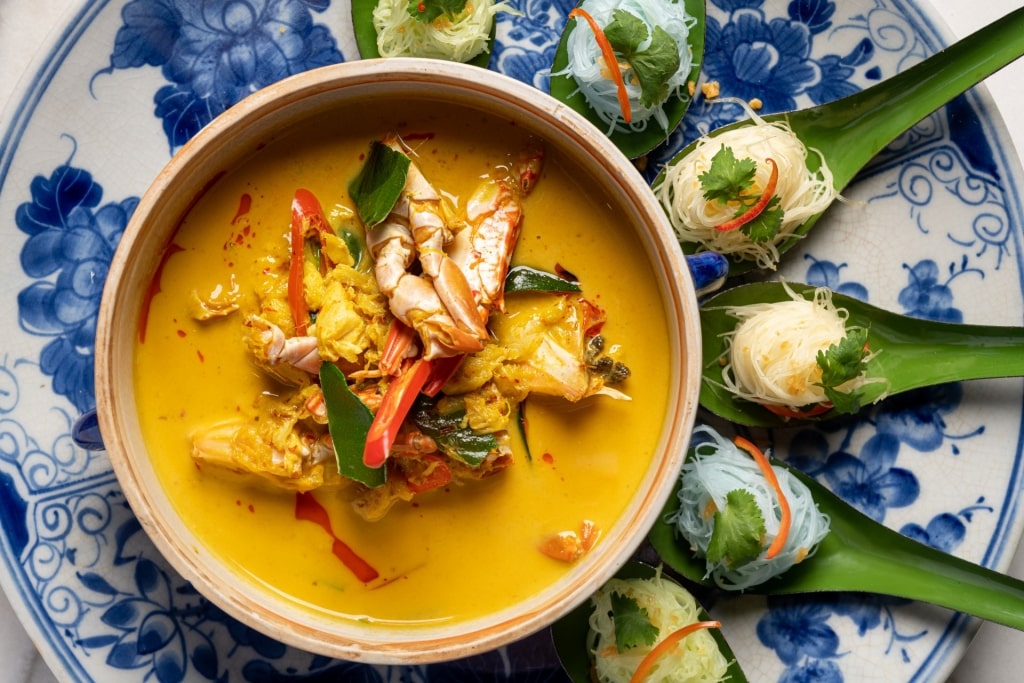
Crab curry
Even in a country renowned for its superb cuisine, Phuket stands out as a real dining destination for Thai gourmands. Each city or region of Thailand is fiercely proud of its own distinctive specialty dishes.
The food of Southern Thailand is beloved for its blisteringly spicy, often bracingly sour flavor profile, in contrast to the sweeter, milder Thai dishes popular in Bangkok.
Thanks to its long history as an important port town, Phuket boasts a cuisine that still bears influences from Portuguese traders and Peranakan merchants, among others. The result is a phenomenally nuanced lexicon of curries, stir-fries, soups, and other dishes worth a journey.
While kaeng pu bai cha phlu, or crab curry, can be found throughout Thailand, it’s a southern specialty well-worth seeking out. And there’s no better spot to try it than Raya, a legendary local eatery housed in a 130-year-old Sino-Portuguese building. Little has changed in this restaurant over the decades, giving it a bit of a timewarp vibe.
It’s impossible to order wrong here, but the crab curry is rich, impeccably spiced, and comes brimming with sweet, locally caught crabmeat.
Admire Historic Architecture Along Thalang Road
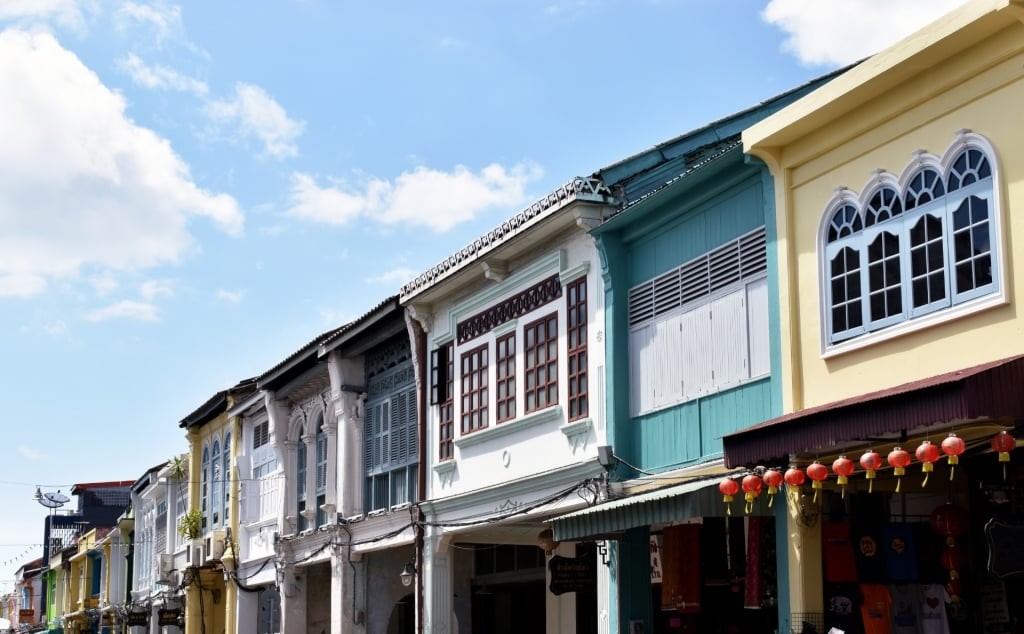
Thalang Road
If you’ve glanced through Instagram shots of Phuket’s Old Town, chances are high that most of them were taken on Thalang Road. Visiting this breathtakingly picturesque pedestrian street, which hosts the Phuket Sunday Walking Street Market each week, is one of the best things to do in Phuket.
Pastel Sino-Portuguese homes in all different shades line the roughly 650-yard stretch. Here, you’ll find everything from boutique shops and art galleries to contemporary cafés and traditional southern Thai restaurants. A standout of the latter is Kopitiam, a Peranakan-influenced café decorated with vintage photos of Phuket.
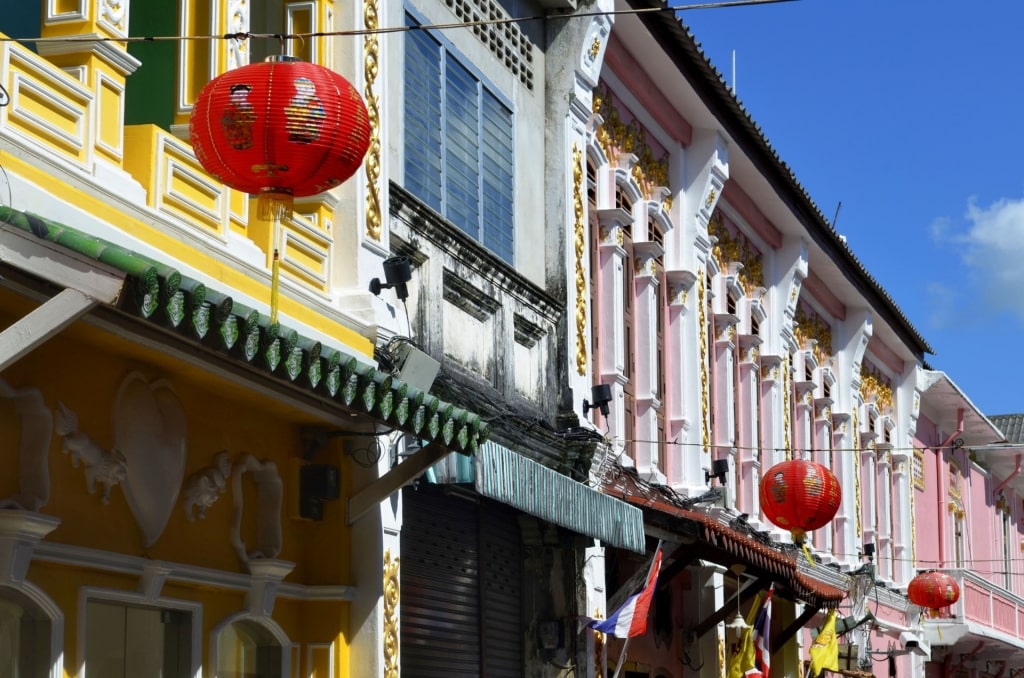
Soi Romanee
Be sure to take a quick detour down Soi Romanee, a side alley off of the main drag of Thalang Road lined with some of the prettiest homes and shophouses on the island.
The Thai government went to great lengths to restore Soi Romanee’s old-fashioned charm by burying power lines and touching up the facades of buildings. The results are nothing short of lovely.
Read: Best Beaches in Phuket
Take a Coffee Break
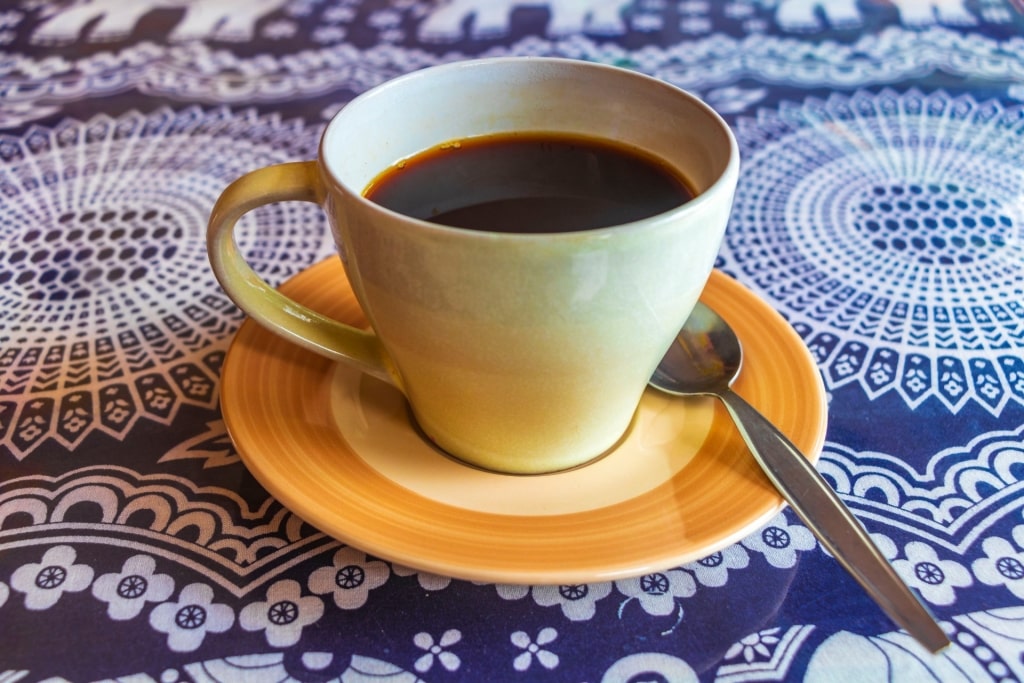
Coffee
A couple of decades ago, coffee in Thailand typically consisted of either instant coffee mixed with condensed milk—a delicious combo still served by street vendors—or Western chains like Starbucks.
Since then, third-wave coffee culture has proliferated throughout the country in a serious way. Thailand is known for its exceptional beans in its verdant north, which local fair-trade companies and social enterprises like Café DoiTung and Akha Ama Coffee roast to perfection.
Even the most judicious of coffee aficionados will find plenty of cafés up to their standards here. One of the most popular is Old Phuket Coffee, located near the intersection of Thalang Road and Yaowarat Road near the Phuket Sunday Walking Street Market in a shophouse decorated with old bicycles and antiques. Serious caffeine fiends should also check out The Shelter Coffee, founded by an award-winning Thai barista.
For those looking for more of a scene with their flat white, Coffs & Burgh pours top-notch espresso in an industrial-chic space. Finally, follow the hordes of Thai Instagram influencers to Endless Summer, an extravagantly decorated house that hosts a combination boutique fashion store and café.
Sample Delicious Local Specialties at the Lock Tien Food Center
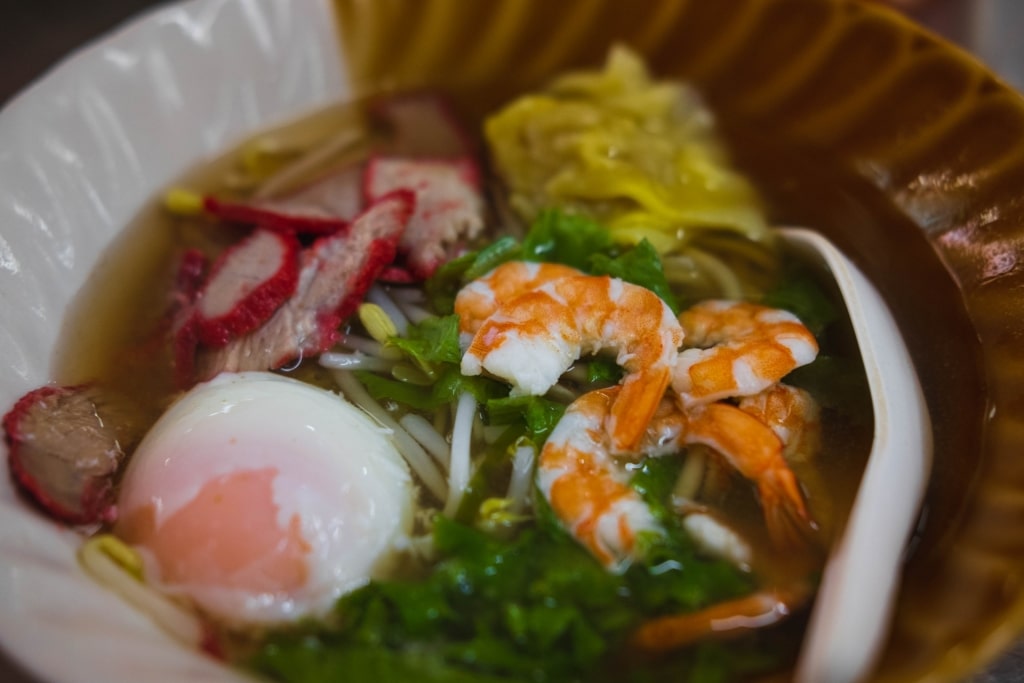
Mee Hokkien
The diversity of Phuket’s cuisine is on sumptuous display at this humble food court. What the fluorescent-bathed space lacks in ambiance it more than makes up for in deliciousness. Prices here cater to locals, which means it’s easy to pile a feast onto your plates for a few hundred baht.
You’ll find everything from Peranakan staples to southern Thai dishes to Hokkien Chinese specialties. Order from as many different stalls as possible and get ready for a gastronomic tour of the island.
Soak in the Scenery on Dibuk Road
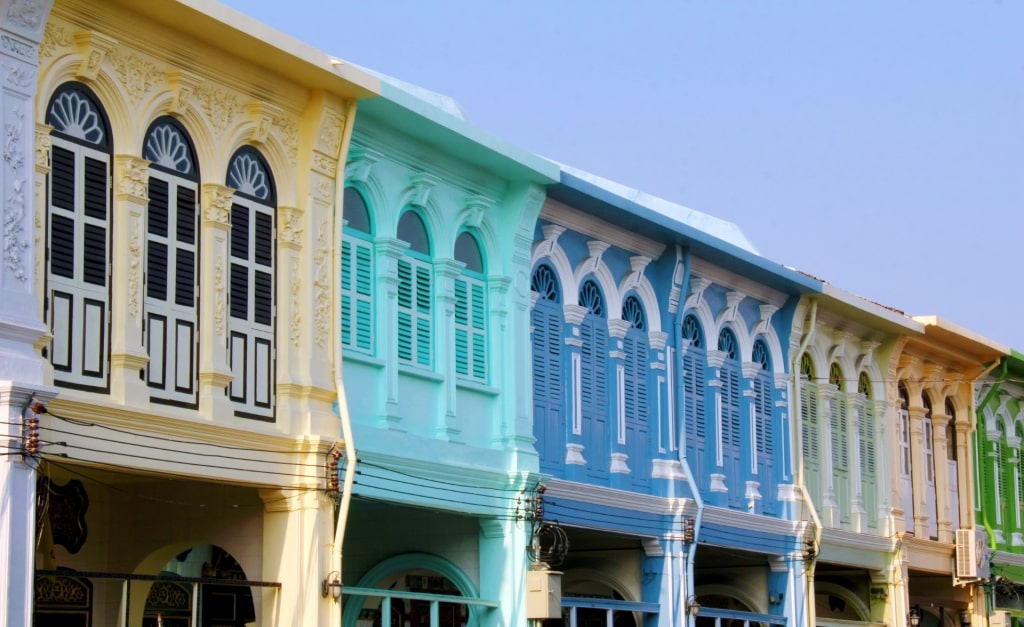
Dibuk Road
While Krabi and Thalang Roads tend to draw the largest crowds of visitors, nearby Dibuk Road is also worth exploring. Like its parallel streets, it features a lineup of pretty pastel shophouses and beautifully preserved examples of Sino-Portuguese architecture.
There are also a few noteworthy street murals, as well as standout shops. Chief among these is Tai Zun Aun, the last surviving traditional blacksmith in the area.
Dibuk Road has a long, storied history with masters of the trade and this shop, which has remained virtually unchanged for decades, offers a fascinating glimpse back in time.
Swap the Pad Thai for Hokkien-Style Noodles
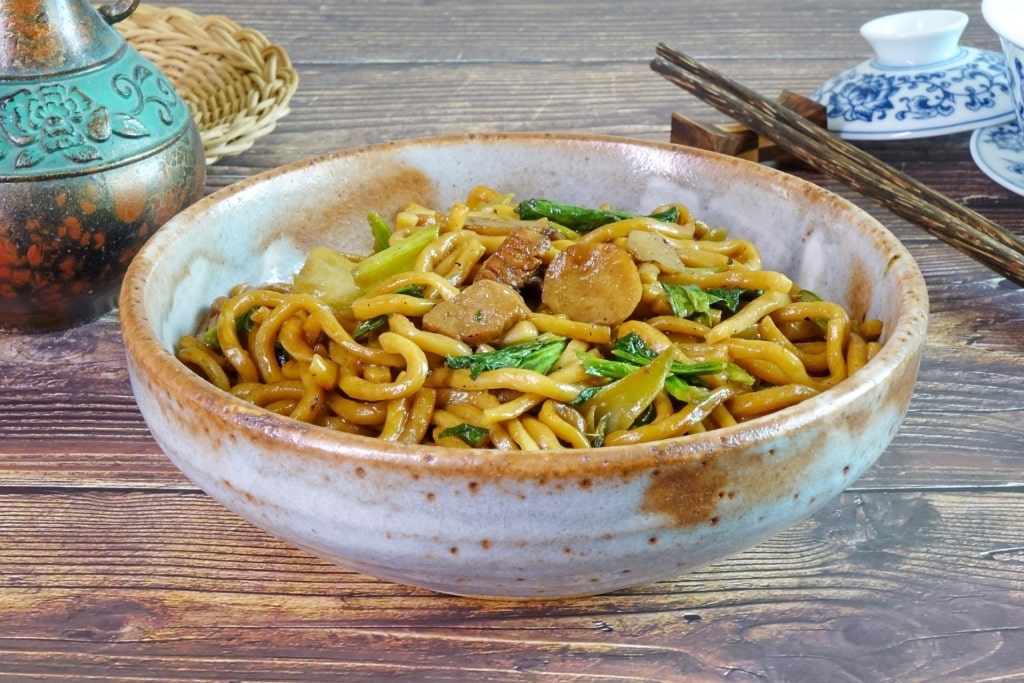
Mee Hokkien
Around the globe, no dish is more synonymous with Thai culture than pad Thai. That’s not a coincidence. The tangle of noodles was invented under a particularly nationalistic prime minister who felt that Thailand needed a national dish to call its own.
Stir-fried rice noodles had already been popularized by the country’s ethnically Chinese population generations ago. Officials launched a campaign to encourage hawkers to prepare a different version of the noodles, one that embodied the balance of sweet, sour, salty, and savory flavors that are the hallmarks of Thai cuisine.
There’s no doubt that pad Thai is tasty, but within its home country, it’s just one of a vast assortment of noodle dishes. In Phuket, one of the local specialties to try is mee Hokkien, or simply “Hokkien noodles.”
This stir-fry of yellow wheat noodles comes swimming in a rich, savory gravy along with seafood and pork. You can find them on practically every street corner, but Mee Ton Poe, which has been frying up plates since 1946, serves one of the best versions in town.
Peruse the Phuket Sunday Walking Street Market
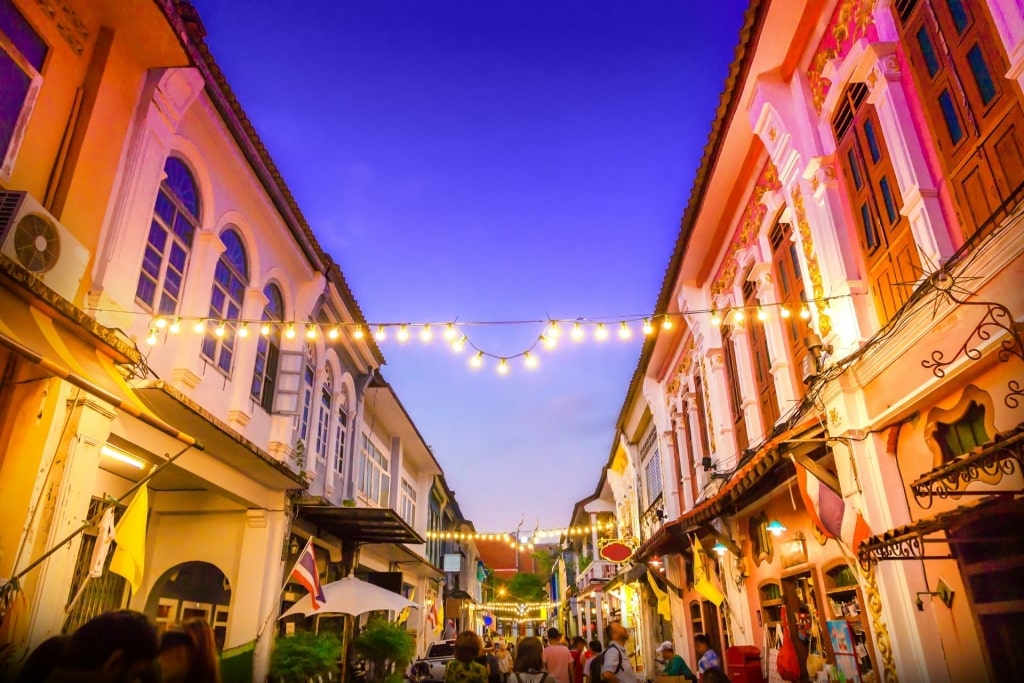
Phuket Sunday Walking Street Market
Phuket’s historic Old Town has a plethora of markets, both large and small, but none can match the eclectic charm of this weekly street market.
If you have the good fortune to be in town on a Sunday, this riotous bazaar is worth checking out for the people-watching alone. Locals typically refer to it as Lard Yai Market and occupies nearly a quarter mile of Thalang Road from roughly 4pm to 9pm.
As with most markets in Thailand, shoppers can expect a wide range of wares running the gamut from tourist trinkets to genuine handicrafts.
Note that while some merchants are open to a little friendly negotiation, serious haggling is frowned upon here. If polite bargaining with a smile fails to yield a better deal, either pay the requested price or move along to another vendor.
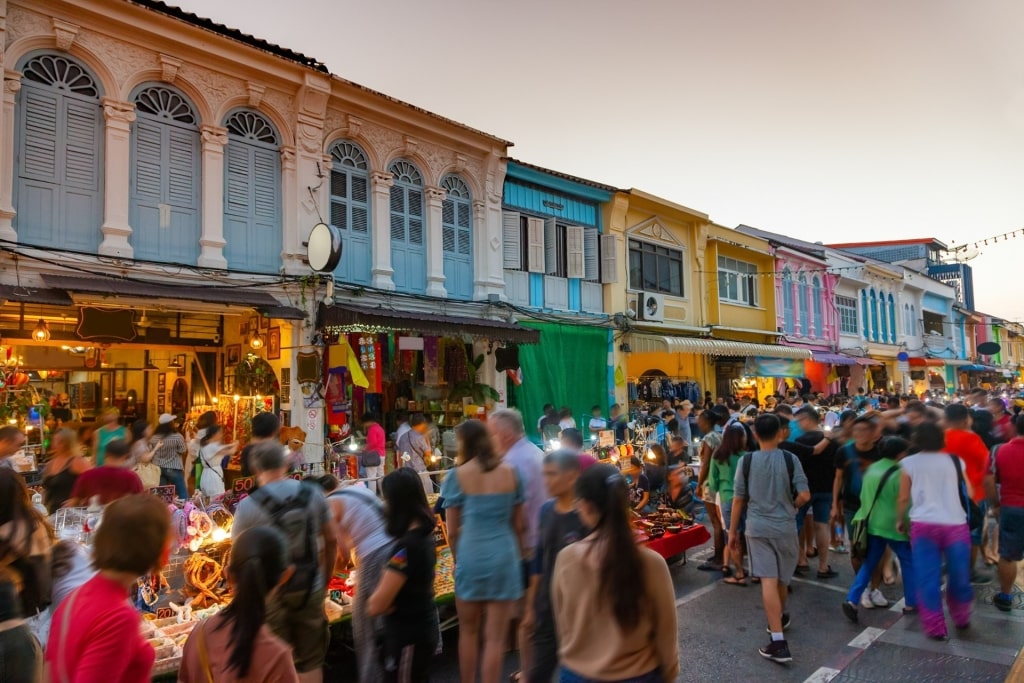
Phuket Sunday Walking Street Market
The Phuket Sunday Walking Street Market is as much about the scene as it is about the actual goods on sale, however. As the market runs through a scenic stretch of town lined with traditional Sino-Portuguese houses and shop houses, it’s an absolute dream for amateur photographers. Buskers routinely entertain the crowds with everything from break-dancing to reggae tunes.
And of course, the food is sensational. While you can expect to see quite a few farang (Thai slang for foreigner) faces here, locals also regularly pass through just to eat. Unlike larger, stationary markets, there’s no real order to the layout here and hawker stands are scattered throughout the length of the road.
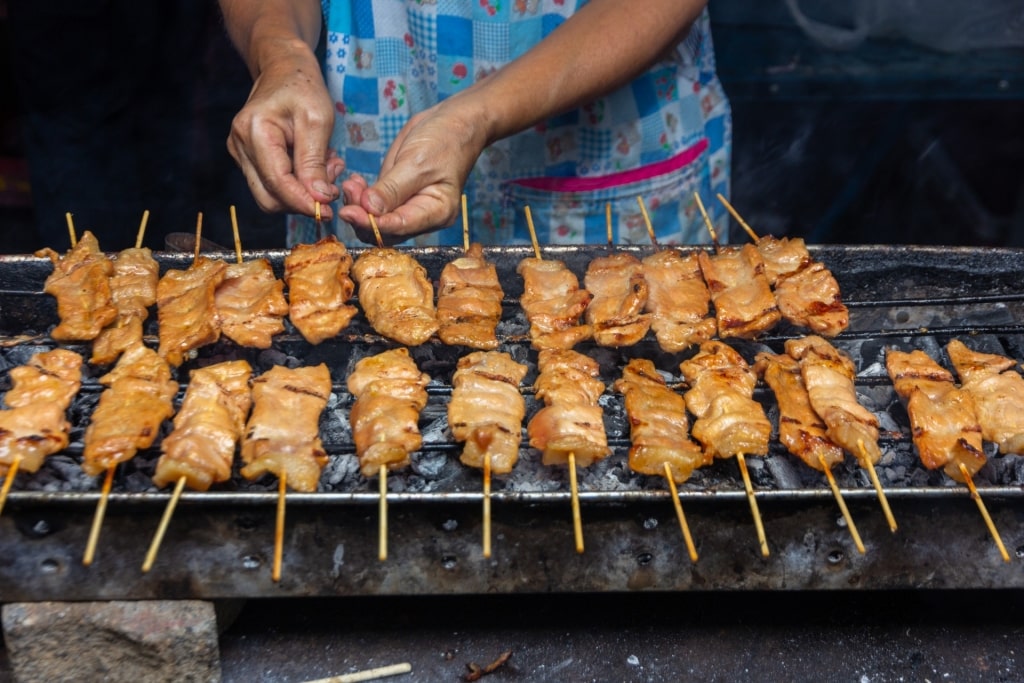
Moo ping
Available dishes range from the relatively portable moo ping (sweet, glazed pork skewers) and gai yang (grilled chicken) to larger plates like hoy tod (crispy, chewy oyster omelet), which may make you want to find a seat somewhere.
For a sweet treat, keep an eye out for the ubiquitous khao niao ma muang (mango sticky rice). When made correctly, the dish balances perfectly ripe, juicy mango with a slightly salty coconut-palm sugar sauce and sticky rice fragrant with more coconut and, often, pandan leaf.
Snap Photos of Street Art
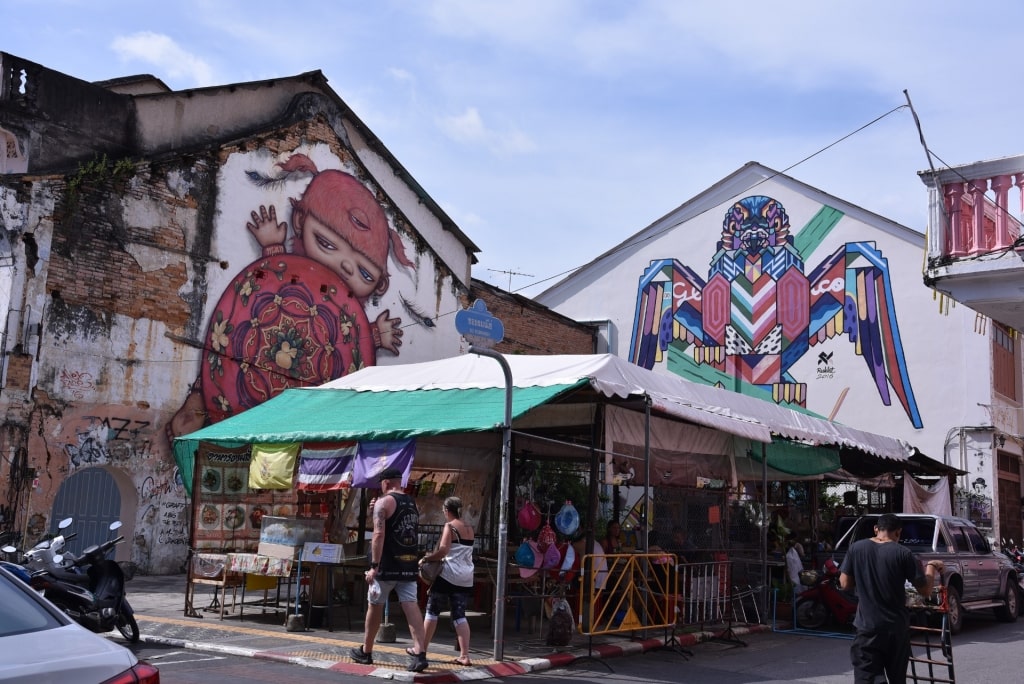
Street art Photo by shankar s. on Flickr, licensed under CC BY 2.0
Large-scale street murals are a relatively new addition to Southeast Asian cities, but very much a welcome one. After works by commissioned street artists helped inject new life and energy into the colonial core of George Town, Penang in Malaysia, cities around the region from Hong Kong to Bangkok followed suit.
Visitors to Phuket Town can admire impressive murals by both Thai and international artists. While the densest concentration of artwork can be found along the main thoroughfare of Thalang Road, there are original masterpieces scattered all over the place—if only one knows to look for them.
Keep an eye out for works by characters by Alex Face, a Bangkok-based street artist whose real name is Patcharapol Tangreun, boldly hued geometric pieces by Rukkit Khuanhawate, and wide-eyed birds by Mue Bon.
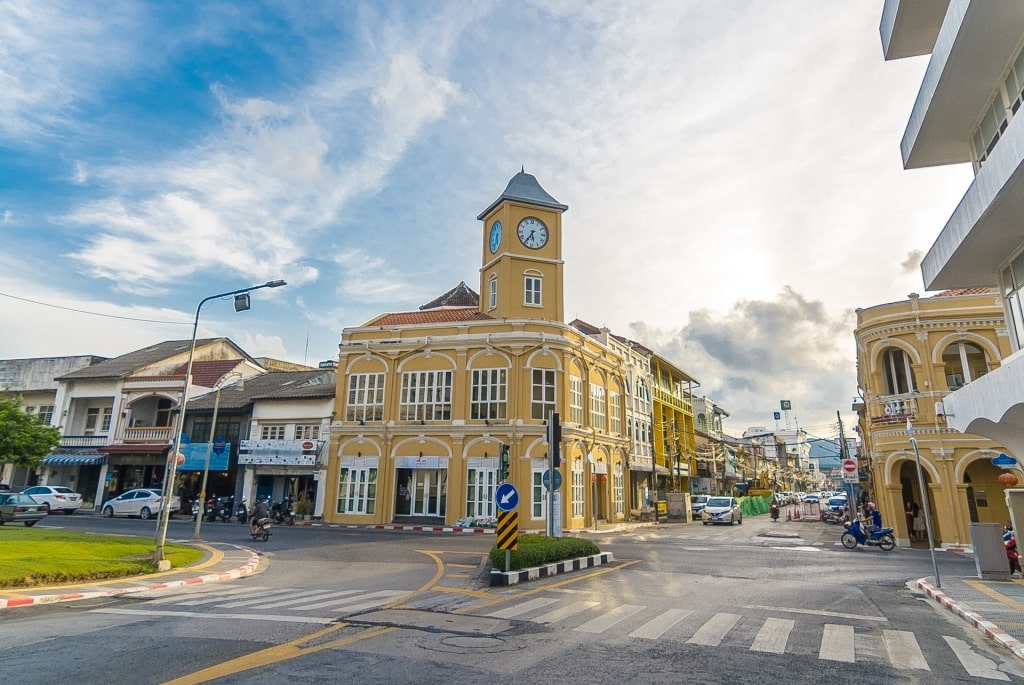
Old Phuket Town
Discover all that Thailand’s largest island has to offer on a cruise to the Land of Smiles. Peruse our Phuket cruises and book your next voyage today.



